Corporate Financial Statements: Uses, Limitations, and Key Concepts
VerifiedAdded on 2023/06/18
|6
|1288
|435
Report
AI Summary
This report provides a detailed analysis of corporate financial statements, focusing on their uses and limitations. It begins by introducing the core components of financial statements, including income statements, statements of retained earnings, balance sheets, and statements of cash flow, emphasizing their interconnectedness in portraying a firm's financial position. The report then delves into five key accounting concepts used in preparing financial statements: currency measurement, going concern, secretarial cost, accrual, and accounting period concepts, illustrating each with practical examples. Furthermore, it examines the qualitative characteristics that make financial reports useful, such as understandability, reliability, relevance, comparability, and timeliness. The report concludes by highlighting the importance of these accounting concepts in enhancing the quality and reliability of financial statements, aiding in effective business decision-making by providing management and investors with valuable financial data.
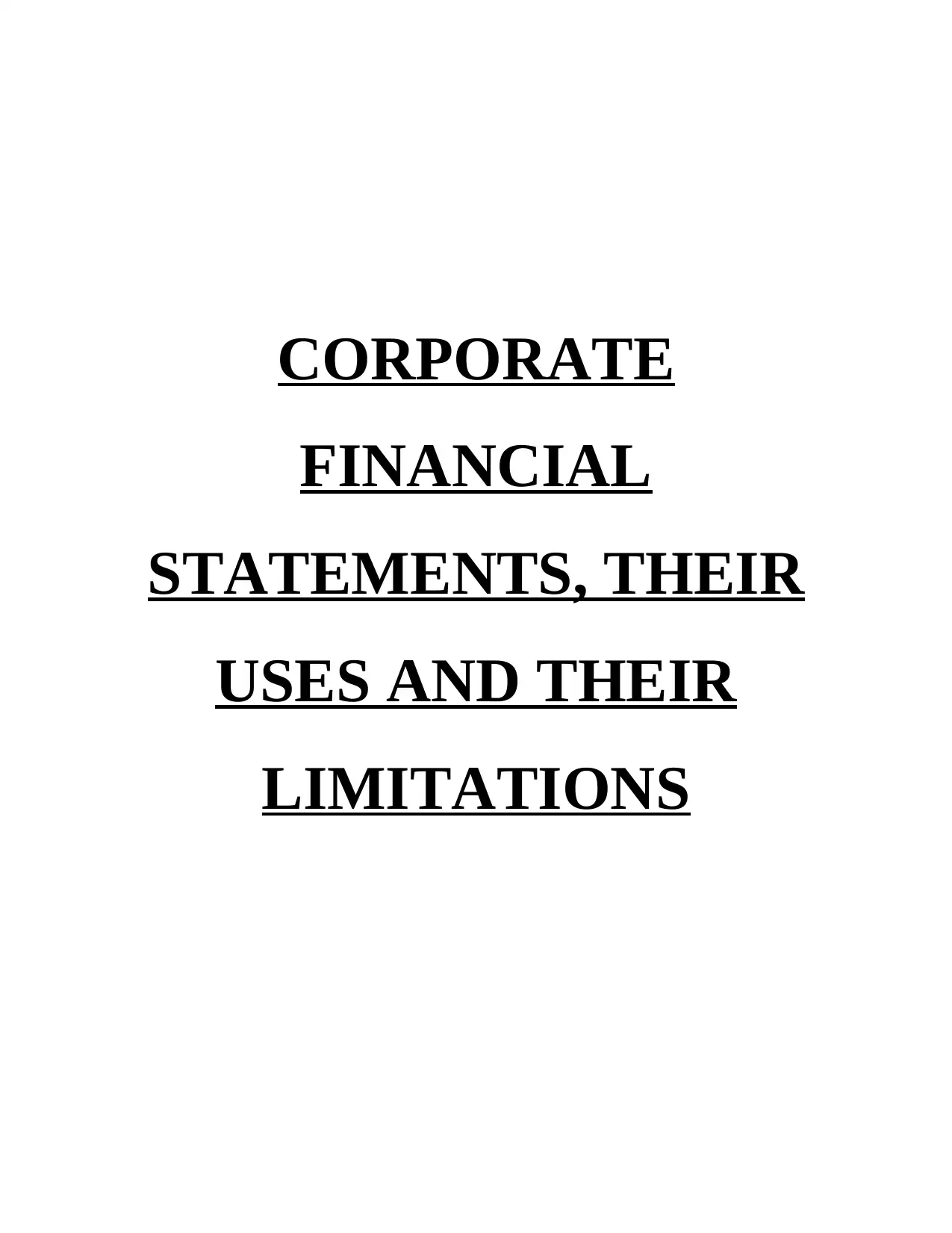
CORPORATE
FINANCIAL
STATEMENTS, THEIR
USES AND THEIR
LIMITATIONS
FINANCIAL
STATEMENTS, THEIR
USES AND THEIR
LIMITATIONS
Paraphrase This Document
Need a fresh take? Get an instant paraphrase of this document with our AI Paraphraser
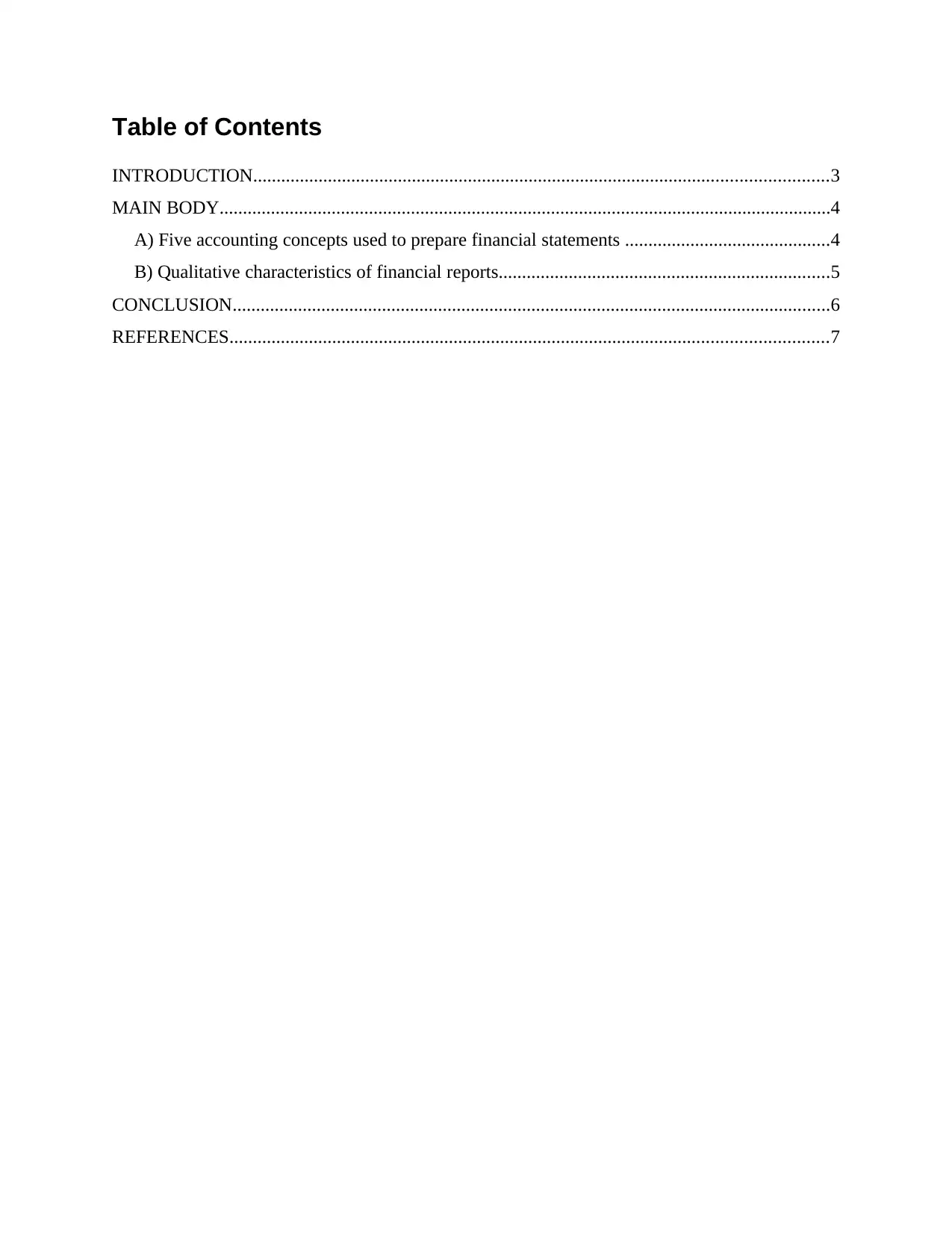
Table of Contents
INTRODUCTION...........................................................................................................................3
MAIN BODY...................................................................................................................................4
A) Five accounting concepts used to prepare financial statements ............................................4
B) Qualitative characteristics of financial reports.......................................................................5
CONCLUSION................................................................................................................................6
REFERENCES................................................................................................................................7
INTRODUCTION...........................................................................................................................3
MAIN BODY...................................................................................................................................4
A) Five accounting concepts used to prepare financial statements ............................................4
B) Qualitative characteristics of financial reports.......................................................................5
CONCLUSION................................................................................................................................6
REFERENCES................................................................................................................................7
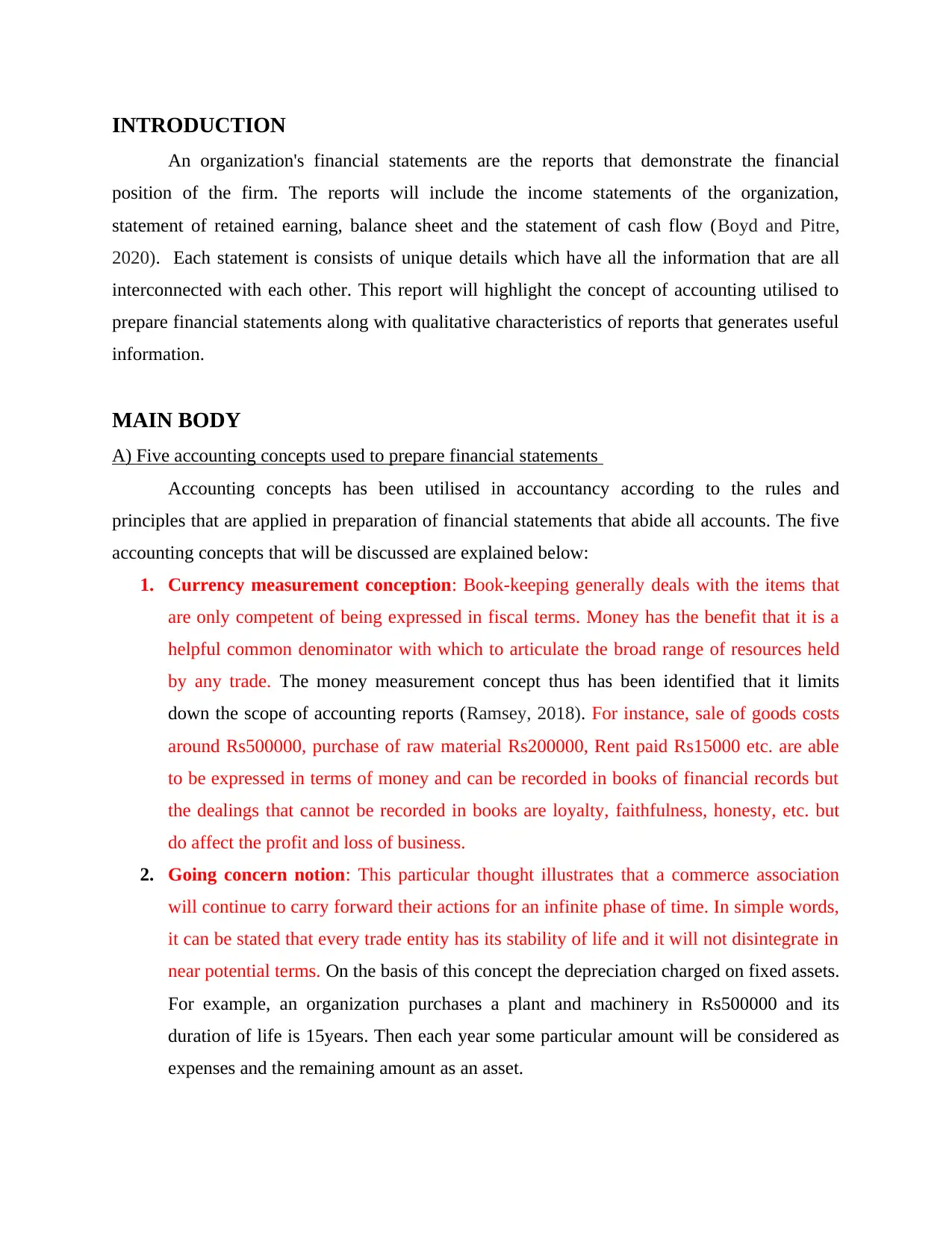
INTRODUCTION
An organization's financial statements are the reports that demonstrate the financial
position of the firm. The reports will include the income statements of the organization,
statement of retained earning, balance sheet and the statement of cash flow (Boyd and Pitre,
2020). Each statement is consists of unique details which have all the information that are all
interconnected with each other. This report will highlight the concept of accounting utilised to
prepare financial statements along with qualitative characteristics of reports that generates useful
information.
MAIN BODY
A) Five accounting concepts used to prepare financial statements
Accounting concepts has been utilised in accountancy according to the rules and
principles that are applied in preparation of financial statements that abide all accounts. The five
accounting concepts that will be discussed are explained below:
1. Currency measurement conception: Book-keeping generally deals with the items that
are only competent of being expressed in fiscal terms. Money has the benefit that it is a
helpful common denominator with which to articulate the broad range of resources held
by any trade. The money measurement concept thus has been identified that it limits
down the scope of accounting reports (Ramsey, 2018). For instance, sale of goods costs
around Rs500000, purchase of raw material Rs200000, Rent paid Rs15000 etc. are able
to be expressed in terms of money and can be recorded in books of financial records but
the dealings that cannot be recorded in books are loyalty, faithfulness, honesty, etc. but
do affect the profit and loss of business.
2. Going concern notion: This particular thought illustrates that a commerce association
will continue to carry forward their actions for an infinite phase of time. In simple words,
it can be stated that every trade entity has its stability of life and it will not disintegrate in
near potential terms. On the basis of this concept the depreciation charged on fixed assets.
For example, an organization purchases a plant and machinery in Rs500000 and its
duration of life is 15years. Then each year some particular amount will be considered as
expenses and the remaining amount as an asset.
An organization's financial statements are the reports that demonstrate the financial
position of the firm. The reports will include the income statements of the organization,
statement of retained earning, balance sheet and the statement of cash flow (Boyd and Pitre,
2020). Each statement is consists of unique details which have all the information that are all
interconnected with each other. This report will highlight the concept of accounting utilised to
prepare financial statements along with qualitative characteristics of reports that generates useful
information.
MAIN BODY
A) Five accounting concepts used to prepare financial statements
Accounting concepts has been utilised in accountancy according to the rules and
principles that are applied in preparation of financial statements that abide all accounts. The five
accounting concepts that will be discussed are explained below:
1. Currency measurement conception: Book-keeping generally deals with the items that
are only competent of being expressed in fiscal terms. Money has the benefit that it is a
helpful common denominator with which to articulate the broad range of resources held
by any trade. The money measurement concept thus has been identified that it limits
down the scope of accounting reports (Ramsey, 2018). For instance, sale of goods costs
around Rs500000, purchase of raw material Rs200000, Rent paid Rs15000 etc. are able
to be expressed in terms of money and can be recorded in books of financial records but
the dealings that cannot be recorded in books are loyalty, faithfulness, honesty, etc. but
do affect the profit and loss of business.
2. Going concern notion: This particular thought illustrates that a commerce association
will continue to carry forward their actions for an infinite phase of time. In simple words,
it can be stated that every trade entity has its stability of life and it will not disintegrate in
near potential terms. On the basis of this concept the depreciation charged on fixed assets.
For example, an organization purchases a plant and machinery in Rs500000 and its
duration of life is 15years. Then each year some particular amount will be considered as
expenses and the remaining amount as an asset.
⊘ This is a preview!⊘
Do you want full access?
Subscribe today to unlock all pages.

Trusted by 1+ million students worldwide
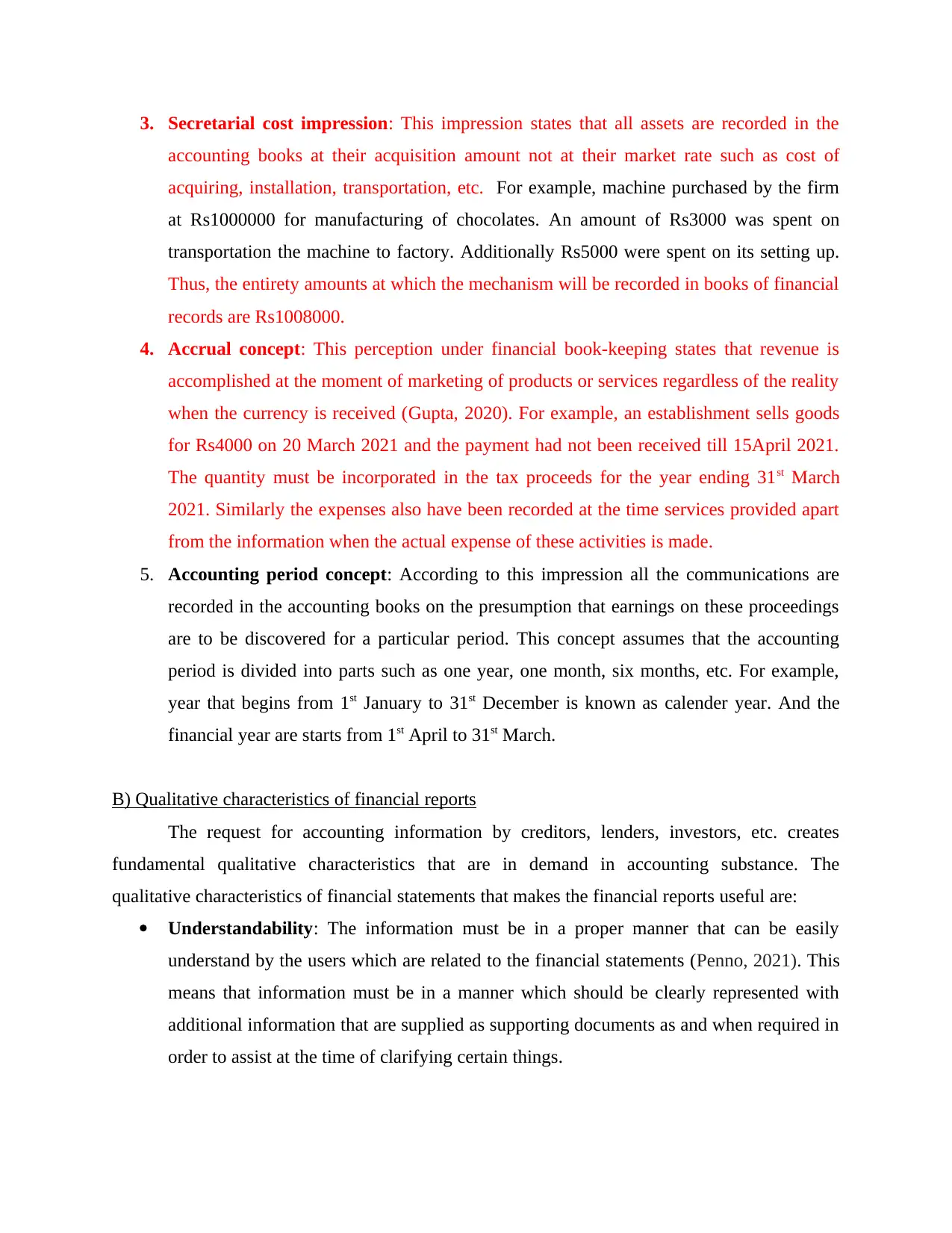
3. Secretarial cost impression: This impression states that all assets are recorded in the
accounting books at their acquisition amount not at their market rate such as cost of
acquiring, installation, transportation, etc. For example, machine purchased by the firm
at Rs1000000 for manufacturing of chocolates. An amount of Rs3000 was spent on
transportation the machine to factory. Additionally Rs5000 were spent on its setting up.
Thus, the entirety amounts at which the mechanism will be recorded in books of financial
records are Rs1008000.
4. Accrual concept: This perception under financial book-keeping states that revenue is
accomplished at the moment of marketing of products or services regardless of the reality
when the currency is received (Gupta, 2020). For example, an establishment sells goods
for Rs4000 on 20 March 2021 and the payment had not been received till 15April 2021.
The quantity must be incorporated in the tax proceeds for the year ending 31st March
2021. Similarly the expenses also have been recorded at the time services provided apart
from the information when the actual expense of these activities is made.
5. Accounting period concept: According to this impression all the communications are
recorded in the accounting books on the presumption that earnings on these proceedings
are to be discovered for a particular period. This concept assumes that the accounting
period is divided into parts such as one year, one month, six months, etc. For example,
year that begins from 1st January to 31st December is known as calender year. And the
financial year are starts from 1st April to 31st March.
B) Qualitative characteristics of financial reports
The request for accounting information by creditors, lenders, investors, etc. creates
fundamental qualitative characteristics that are in demand in accounting substance. The
qualitative characteristics of financial statements that makes the financial reports useful are:
Understandability: The information must be in a proper manner that can be easily
understand by the users which are related to the financial statements (Penno, 2021). This
means that information must be in a manner which should be clearly represented with
additional information that are supplied as supporting documents as and when required in
order to assist at the time of clarifying certain things.
accounting books at their acquisition amount not at their market rate such as cost of
acquiring, installation, transportation, etc. For example, machine purchased by the firm
at Rs1000000 for manufacturing of chocolates. An amount of Rs3000 was spent on
transportation the machine to factory. Additionally Rs5000 were spent on its setting up.
Thus, the entirety amounts at which the mechanism will be recorded in books of financial
records are Rs1008000.
4. Accrual concept: This perception under financial book-keeping states that revenue is
accomplished at the moment of marketing of products or services regardless of the reality
when the currency is received (Gupta, 2020). For example, an establishment sells goods
for Rs4000 on 20 March 2021 and the payment had not been received till 15April 2021.
The quantity must be incorporated in the tax proceeds for the year ending 31st March
2021. Similarly the expenses also have been recorded at the time services provided apart
from the information when the actual expense of these activities is made.
5. Accounting period concept: According to this impression all the communications are
recorded in the accounting books on the presumption that earnings on these proceedings
are to be discovered for a particular period. This concept assumes that the accounting
period is divided into parts such as one year, one month, six months, etc. For example,
year that begins from 1st January to 31st December is known as calender year. And the
financial year are starts from 1st April to 31st March.
B) Qualitative characteristics of financial reports
The request for accounting information by creditors, lenders, investors, etc. creates
fundamental qualitative characteristics that are in demand in accounting substance. The
qualitative characteristics of financial statements that makes the financial reports useful are:
Understandability: The information must be in a proper manner that can be easily
understand by the users which are related to the financial statements (Penno, 2021). This
means that information must be in a manner which should be clearly represented with
additional information that are supplied as supporting documents as and when required in
order to assist at the time of clarifying certain things.
Paraphrase This Document
Need a fresh take? Get an instant paraphrase of this document with our AI Paraphraser
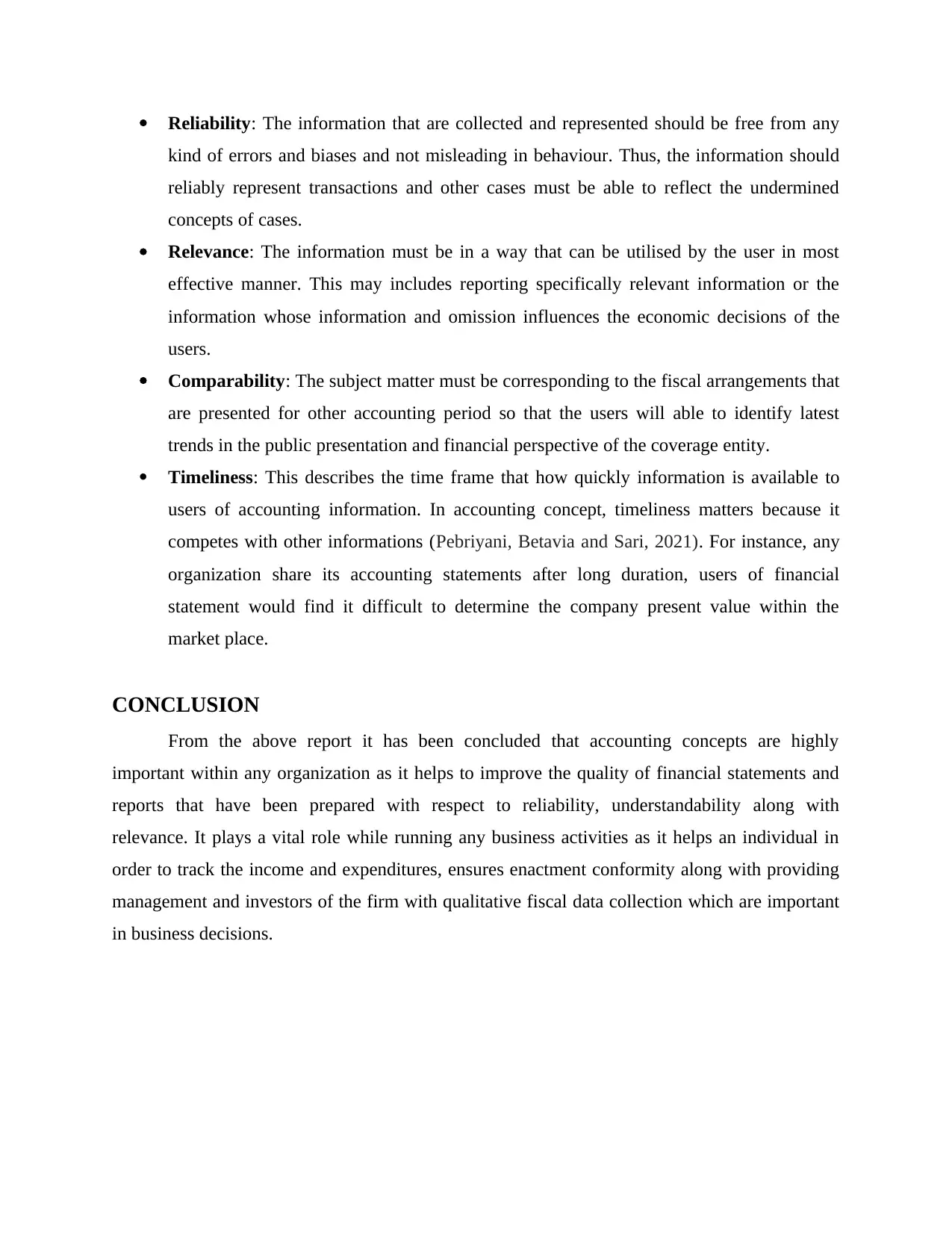
Reliability: The information that are collected and represented should be free from any
kind of errors and biases and not misleading in behaviour. Thus, the information should
reliably represent transactions and other cases must be able to reflect the undermined
concepts of cases.
Relevance: The information must be in a way that can be utilised by the user in most
effective manner. This may includes reporting specifically relevant information or the
information whose information and omission influences the economic decisions of the
users.
Comparability: The subject matter must be corresponding to the fiscal arrangements that
are presented for other accounting period so that the users will able to identify latest
trends in the public presentation and financial perspective of the coverage entity.
Timeliness: This describes the time frame that how quickly information is available to
users of accounting information. In accounting concept, timeliness matters because it
competes with other informations (Pebriyani, Betavia and Sari, 2021). For instance, any
organization share its accounting statements after long duration, users of financial
statement would find it difficult to determine the company present value within the
market place.
CONCLUSION
From the above report it has been concluded that accounting concepts are highly
important within any organization as it helps to improve the quality of financial statements and
reports that have been prepared with respect to reliability, understandability along with
relevance. It plays a vital role while running any business activities as it helps an individual in
order to track the income and expenditures, ensures enactment conformity along with providing
management and investors of the firm with qualitative fiscal data collection which are important
in business decisions.
kind of errors and biases and not misleading in behaviour. Thus, the information should
reliably represent transactions and other cases must be able to reflect the undermined
concepts of cases.
Relevance: The information must be in a way that can be utilised by the user in most
effective manner. This may includes reporting specifically relevant information or the
information whose information and omission influences the economic decisions of the
users.
Comparability: The subject matter must be corresponding to the fiscal arrangements that
are presented for other accounting period so that the users will able to identify latest
trends in the public presentation and financial perspective of the coverage entity.
Timeliness: This describes the time frame that how quickly information is available to
users of accounting information. In accounting concept, timeliness matters because it
competes with other informations (Pebriyani, Betavia and Sari, 2021). For instance, any
organization share its accounting statements after long duration, users of financial
statement would find it difficult to determine the company present value within the
market place.
CONCLUSION
From the above report it has been concluded that accounting concepts are highly
important within any organization as it helps to improve the quality of financial statements and
reports that have been prepared with respect to reliability, understandability along with
relevance. It plays a vital role while running any business activities as it helps an individual in
order to track the income and expenditures, ensures enactment conformity along with providing
management and investors of the firm with qualitative fiscal data collection which are important
in business decisions.
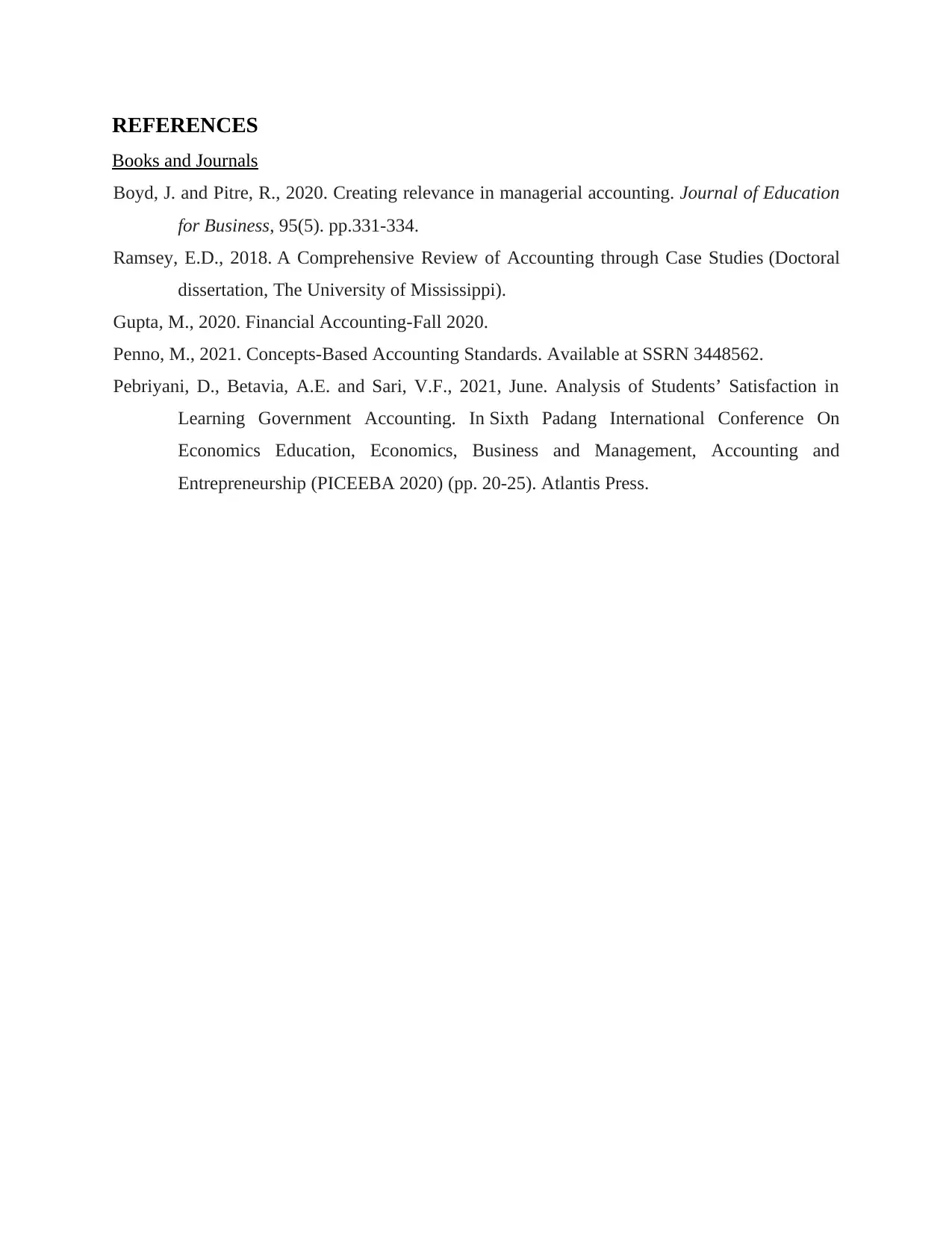
REFERENCES
Books and Journals
Boyd, J. and Pitre, R., 2020. Creating relevance in managerial accounting. Journal of Education
for Business, 95(5). pp.331-334.
Ramsey, E.D., 2018. A Comprehensive Review of Accounting through Case Studies (Doctoral
dissertation, The University of Mississippi).
Gupta, M., 2020. Financial Accounting-Fall 2020.
Penno, M., 2021. Concepts-Based Accounting Standards. Available at SSRN 3448562.
Pebriyani, D., Betavia, A.E. and Sari, V.F., 2021, June. Analysis of Students’ Satisfaction in
Learning Government Accounting. In Sixth Padang International Conference On
Economics Education, Economics, Business and Management, Accounting and
Entrepreneurship (PICEEBA 2020) (pp. 20-25). Atlantis Press.
Books and Journals
Boyd, J. and Pitre, R., 2020. Creating relevance in managerial accounting. Journal of Education
for Business, 95(5). pp.331-334.
Ramsey, E.D., 2018. A Comprehensive Review of Accounting through Case Studies (Doctoral
dissertation, The University of Mississippi).
Gupta, M., 2020. Financial Accounting-Fall 2020.
Penno, M., 2021. Concepts-Based Accounting Standards. Available at SSRN 3448562.
Pebriyani, D., Betavia, A.E. and Sari, V.F., 2021, June. Analysis of Students’ Satisfaction in
Learning Government Accounting. In Sixth Padang International Conference On
Economics Education, Economics, Business and Management, Accounting and
Entrepreneurship (PICEEBA 2020) (pp. 20-25). Atlantis Press.
⊘ This is a preview!⊘
Do you want full access?
Subscribe today to unlock all pages.

Trusted by 1+ million students worldwide
1 out of 6
Related Documents
Your All-in-One AI-Powered Toolkit for Academic Success.
+13062052269
info@desklib.com
Available 24*7 on WhatsApp / Email
![[object Object]](/_next/static/media/star-bottom.7253800d.svg)
Unlock your academic potential
Copyright © 2020–2025 A2Z Services. All Rights Reserved. Developed and managed by ZUCOL.




